Want to understand what it means to "sing on key?" The following is the holy grail of music theory - the tree that all of the branches grow from. Understanding The Circle of Fifths will help you understand the music you love, jam with musicians, and improvise with your favorite songs.
FAST MUSIC THEORY - CHAPTER 4

“Music is the movement of sound to reach the soul for the education of its virtue.”
-Plato
The Circle of Fifths
We typically don’t play with all 12 notes at the same time. Songs and pieces tend to exist in a subset of 7 notes called a key (not to be confused with individual keys of a piano). There are 12 keys, and they are related to each other in specific ways. Understanding their relationship unlocks the holy grail of musical patterns.
As discussed in Chapter 1: 12 Tones, there are 12 notes within each octave. When we are playing a song or piece, we usually block out 5 of those and only focus on a particular 7. Each key is centered on one of our 12 notes, and understanding them can be frustrating. Music teachers typically pass this image out to students and say “memorize this.”
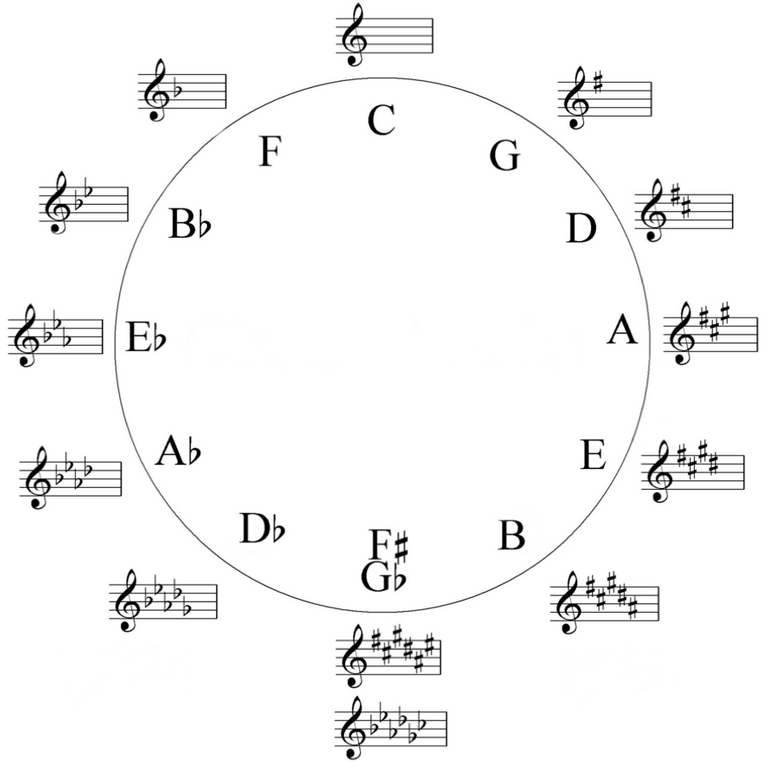
Memorize it? But I thought music was supposed to be fun….
Alright, it is useful, but even the memorization of this doomsday clock isn’t that helpful by itself; we need to understand why it is the way it is. Again, piano imagery will help tremendously right now. Here is our image from Chapter 1: 12 Tones if you need a refresher.

We begin with the key of C for the simple reason that it is the simplest key to understand. I’ve outlined the notes in the key of C major. Playing these notes on a piano/keyboard/app will help you understand!
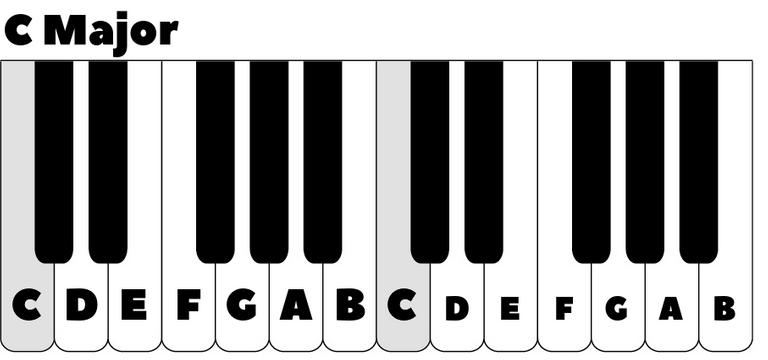
Alright, here we are in the key of C major. There are two important rules that we need to acknowledge to figure out other keys. The first is that every key requires one instance of each letter. The second involves the note a half step below our root, C. See that note? That’s our leading tone, a B. If you play these notes starting on C and end your playing on B, your brain will BEG you to finish on C. Given the right context, B is the deepest tension, and C is the release. So, quickly, here are our two criteria for major keys at the moment:
- One instance of each letter
- A leading tone, or a note that is one half step below the root
Sharps
If we know how to play the key of C, it seems that we would intuitively try the surrounding notes to see what their scales look like. D major has two sharps, B major has five… But where did they come from? Why those particular sharps? No noticeable pattern is present other than the whole steps and half steps that go into making each one. The secret is to move up a fifth (Chapter 3: Intervals) to the most closely related key. To find a fifth easily, we can just count up to the fifth note in the scale we just played (C-D-E-F-G). Here it is.
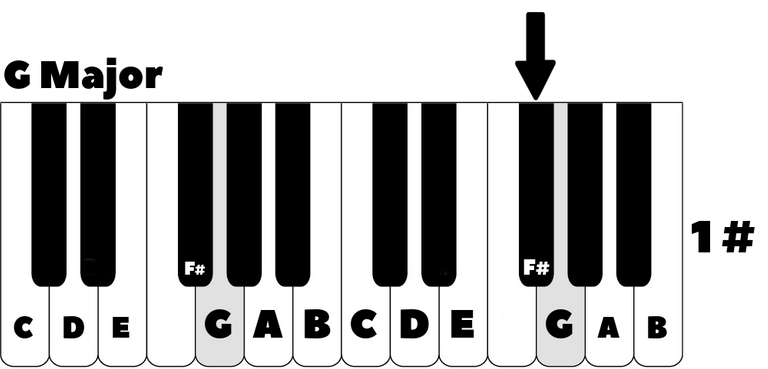
Bingo. The notes are exactly the same as in the key of C major except for one note: F#. The F is raised to F# because that is the leading tone of G. The keys of C and G are closely related. Let’s count our notes to find the fifth above G (G-A-B-C-D)— our next key is D. A half step below D is C#, which is our leading tone. This means we will replace C with C# to acquire our second sharp.
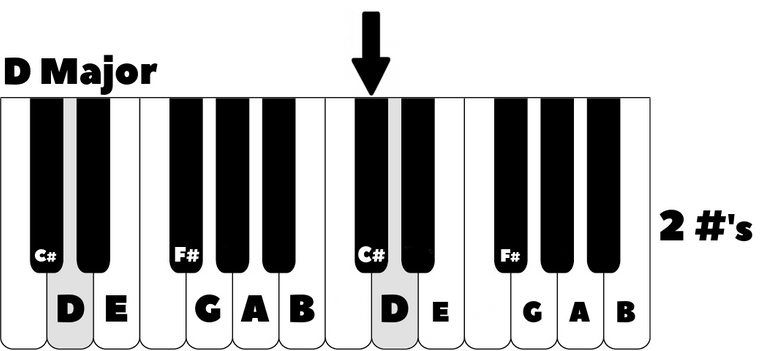
SHARP TIP: The sharps in each key are cumulative, meaning a key that has 4 sharps and a key that has 5 sharps will share the same 4 sharps.
Alright, what is a fifth above D? Take a look at each one carefully to make sure you understand what’s happening. Try to guess what the next one will be each time.
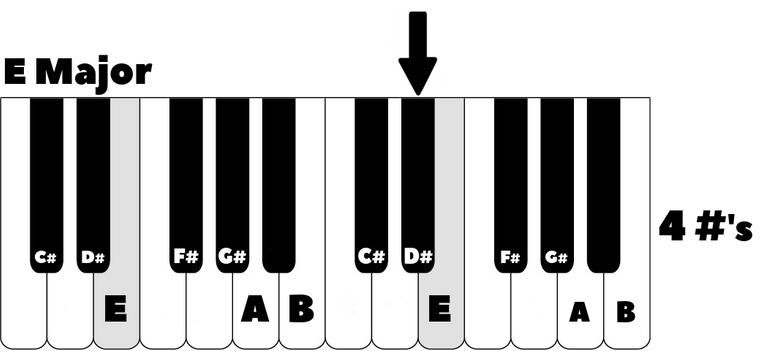
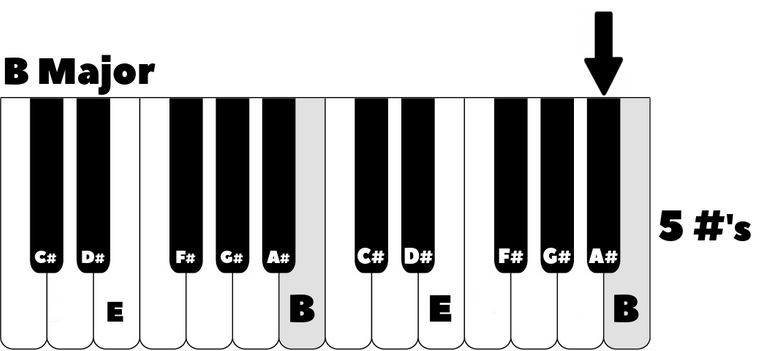
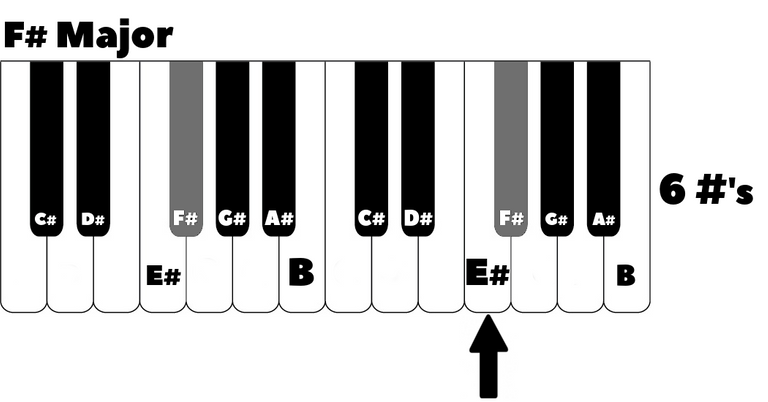
This is where things get strange. In the key of F# major, notice that the leading tone is a white key (E#). How is a white key a sharp? Remember that one of our conditions for a key is that it needs one of each letter. If we give each of the notes their normal names, we get this set: F#, G#, A#, B, C#, D#, F, F# — There’s no E! We can force F to be called E# so it complies with the rules. This may seem ridiculous, but it’s extremely helpful in specific scenarios. On to the the next key!
Wait… That would be the key of C# major with the leading tone B# (because we can’t have two C’s and we need some kind of B). That would give us seven sharps. The key after that would be the key of G# major with the leading tone F (double sharp). There has to be a simpler way…
Flats
This system of adding sharps works for a while, but if we continue, we will add more double sharps until we arrive back to the key of C major, except it will be called the key of B# major instead. This won’t do. The key of G# is never used, and the key of C# is borderline rude (sorry Bach), so let’s go back to the key of F#: what if we renamed all of these notes so that they include flats instead of sharps? We would get this enharmonic spelling.
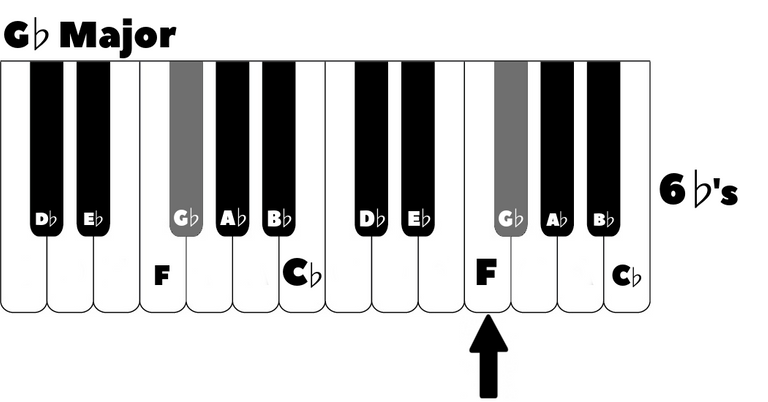
By renaming the notes, we now have 6 flats instead of 6 sharps. Seems like a fair trade! At least they’re the same level of convenience. Notice the C♭; we have this note for the same reason we had E# as our leading tone in the key of F#. We can’t have a B♭ and a B, so we trade out the B for a C♭ to make things consistent. If we move up a fifth, we get the next key, D♭.

Now we only have 5 flats. What happened? The C♭ in the last key has been replaced by the leading tone of D♭, which is C.

We’ve lost another flat! Our G♭ has been replaced by G. See the pattern? The process that creates sharps is the same process that eliminates flats! Let’s keep it rolling.

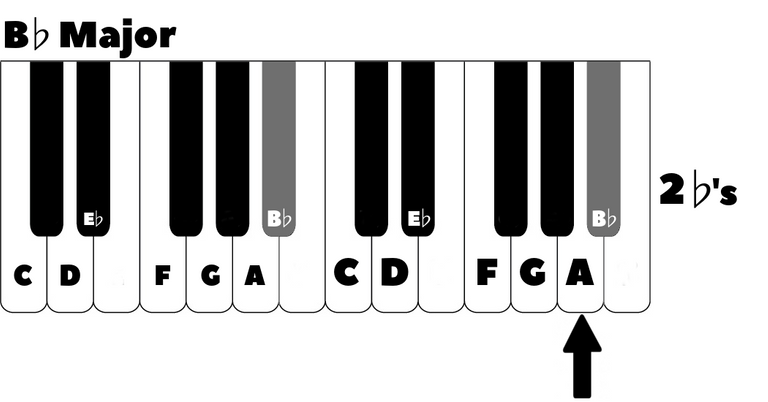
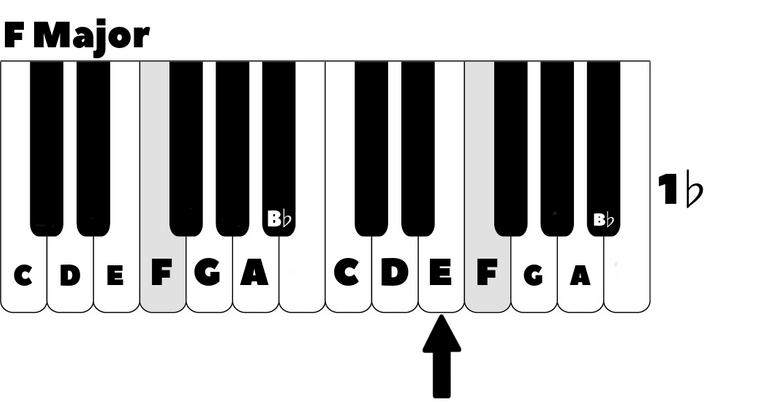
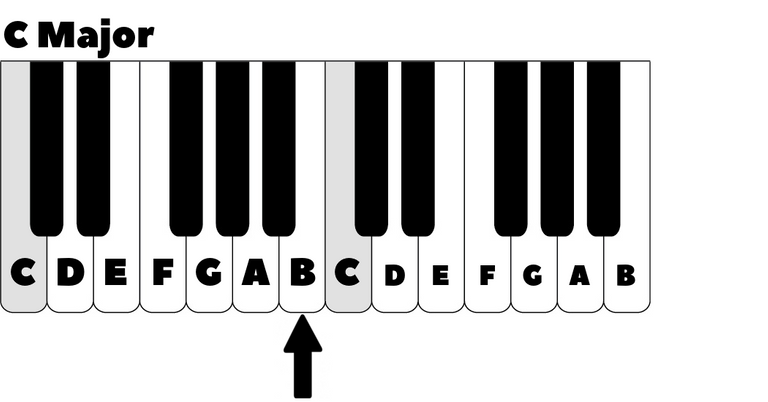
Welcome back! We’re at the beginning again.
Memorizing this whole thing is a feat. However, memorizing the process that makes this whole cycle happen is not difficult. Practice making each key by yourself. In just a few weeks, you’ll be able to maneuver all of the keys in order in less than 5 minutes. I’ve tucked a quick overview of this whole process into the end of this chapter.
Conclusion
The Circle is much more respectable when you realize that it is a representation of nature more than an exercise in mental vanity. The tones that humans around the world have grown to love are based on natural phenomena like the overtone series and directly imply this system. In fact, the first system of its kind was contained within Grammatika, a treatise that was written by composer and theorist Nikolai Diletski in the 1670’s before the fame of classical composers you hear about today like Bach, Mozart, and Beethoven. Any music that is considered “tonal” is paying its respects to this system. An understanding of the Circle of Fifths is a gift that keeps on giving.
Keys are represented in written music in a specific way. The beginning of each piece or song includes a set of sharps or flats. For our purposes, all you really need to do is count how many of either there are and compare that to this circle of fifths chart. Are there four sharps at the beginning? You’re in the key of E major.
… Or you’re in the key of C# minor. More on this in Chapter 7: Modes.

KEY TIP: Some songs and pieces change keys in the middle, sometimes often and sometimes not. This is called modulation. Remember, a song is not necessarily bound by the key it is in.
Circle of Fifths Cheat Sheet
- Each key needs one instance of each letter A-G.
- Each key needs a leading tone, or a note that is one half step below the root.
- Begin in the key of C. It’s the simplest! No sharps or flats.
- Travel in fifths. Your next key is the fifth note of the key you just played.
- Add sharps as leading tones.
- When you get to the key of F#, play that key and then switch it to the key of Gb. Now you can continue.
- New leading tones will now eliminate flats one by one.
- Continue until you arrive back at the key of C.
Any questions? Ask in the comments! Thanks for reading, Steemit!
![]()
Great post! As someone who has taught theory at the college level, I can't stress enough how useful the circle of fifths is. I've listed this post in my new "Top 5 music instructional posts of the week". That means that I'm promoting this post, upvoting with 100% Steem Power, resteeming and following you. Congrats! You can see the full list here: https://steemit.com/music/@musicsteem/my-picks-for-the-top-5-music-instructional-posts-on-steemit-for-week-ending-july-1-2017-upvoting-with-100-steem-power
Hey thanks!
The circle of Fifth was the first thing I had to learn before even being allowed to touch a guitar to tune it.
Music is Math. One can train and develop musical talent - and an ear for the nuances that make up a harmony.
Circle of Fifths? No regrets. Beautiful.
true ,i trained my ear through time ,anybody can be a musician
Yep - as long as one has the interest. :) 🎼
How did you put the treble clef emoji there?
I am using macros on Mac or Linux, however, you can copy/paste from sites like this: http://www.iemoji.com 😎
I'm using a Mac. Is there a site that explains how to use the macros? Hope I'm not bugging you.
so true!
Hello @soundreasoning This story made it to the ღ #steempearls of @tabea . Check it out at https://steemit.com/steempearls/@tabea/steempearls-14
The circle of fifith is great for beginners who wanted to catch up their skills in piano or composing. It is such a basic yet important skill to accquire for every musician! It is great to see you introducing the circle of fifths to our
I am highly bless by going through this post, now I can understand music better, knowing the keys. Good job.
I was scroll through the trending feed and your post caught my attention. Great share. upvoted. Resteemed. Following. Much success to you.
A tritone of a tritone is the same tritone.
Yep. And they are 3 whole-steps from each other. Hence the name tritone.
Finally... Somebody touches on this invaluable information!
@soundreasoning does it again! Thank you. This one I'm keeping in my back pocket for a melodic rainy day
I NEVER thought the C major scale was the easiest scale for any guitar student to learn- who thinks spontaneously CDEFGAB as a beginner as a logical series of note names? And what 4-year old can't say ABCDEFG? Starting there leads nearly immediately to the major scales, but trains the ear for other modalities from the outset, and minor modal thinking breaks some lazy thought patterns.
My early music education was oriented around the keyboard, a substantially illogical fixture of Western music that almost completely ignores the physics of sound (except for the repetitive character of the scale structure).
I try to eliminate every vestige of this conditioning when I teach, looking FIRST at vibrating strings (so theory must be first harmonicly grounded), then at a chromatic scale (whole-step half-step is just plain dumb everywhere else for everything other than keys and standard notation.)
Attentive string students whiz right through the stuff keyboard students frequently stumble over with great difficulty.
When you take a simplest-element approach to theory, you need to use the appropriate terminology for the student (I'm not going to say anything about theory of wave physics to an 8-year old, EVEN WHEN THEY ALREADY WORK WITH IT INTUITIVELY), but I have evidence it works better than simple rote or shoveling standard notation and the Circles on my guitar and mandolin students first thing. They ABSOLUTELY come in early, but not first thing.
HARMONY, HARMONY, HARMONY!
With me, guitar students always begin with the e minor pentatonic scale because it's easy. Children, especially, are more likely to benefit from scale knowledge once they are first presented with the fact that scales can be used for fun. Improvisation in my classroom happens as soon as it can.
Children piano students don't seem to have a hard time grasping CDEFGAB, especially when it's linked to something as simple as "just the white keys." Once someone grasps all of the major scales, I explain that they already know all of the minor scales also and we learn about relative minors. It takes less than 30 minutes for most kids to get this.
I agree with you that students should begin with interval based training. I always start people on note recognition, half steps and whole steps, and then intervals up to the Major 3rd (so they can learn chords easily). Scales and keys come after we've already learned a few songs in the key of C. Sound physics is fun, but doesn't ever make anybody play differently. It's an inspiring talk I give when a student's interest begins to slip, or they've played for enough years that they can think about it creatively.
Ultimately, this post is for anyone interested in understanding music. It's definitely not the first thing I'd start with, so absolute beginners would benefit from reading my theory posts from the beginning :)
I do private instruction, only- just last week, for the first time a local school music director and talked to me for an extended period of time, so that might change. The ratio of guitar to keyboard students is about 8:1, so there's no good reason to focus most students' attention on standard notation early (from which structure nearly all theory pedagogy derives, historically, let's face it).
Agreed. I don't make any beginners read music for many months--It increases my failure rate way too much because it's not initially fun.
I remember when I was 7 starting on piano- there wasn't the slightest hint of improvisation in what I was taught, it was all rote, and I can't think of an instance (admittedly, nearly 60 years later I won't remember much clearly) I EVER heard words like "mess around", "have some fun with it", "explore everything about the instrument"...I utterly refuse to avoid this with my students, so I'll challenge them to come up with any random melodic fragment, or a chord, or a rhythm, and spend at least a minute or two exploring it.
That is excellent!
Great post. This might be a way for me to understand better :0) I use to be the music teatchers worst nightmare not because I couldnt learn to play ( I learned fast) but not by reading notes.....by ear and watching the hands. Once I learnd a song to play I couldnt change to a new note like C or D cause I didnt know what I played it in in the first place :0)
Thx for sharing. Folowed upvoted and resteemed.
All those years of music classes just made sense. Thanks and great post!
click here!This post received a 1.7% upvote from @randowhale thanks to @sighmanjestah! For more information,
I love to play piano and I hear what tone should come next, but I don't know why :) Here I found the theory. Thank you :)Thank you for this @soundreasoning
I think anyone who has an interest in the circle of fiths. they should check out Jacob Collier's interviews, where he explains his way of composing with the circle of fifths.
Going around clockwise brightens and going anti-clockwise is plagal sounding. or darkening.
One should also check out ernst levy's interpretation of negative harmony. Another topic Jacob Collier likes to talk about
I've never thought about moving around the circle as brightening or darkening, but as I think about it I definitely notice Bach and Mozart move things around like that.
I'll check him out!
Wonderful interview with Jacob Collier by June Lee
Postnya very useful and hope you are lucky for future in this steemit :)
But do not forget the upvote on my blog too :D
#Thank's
This is super useful. Thank you for posting!
Massively Cool!
I was taught this stuff in college and even majored in music theory. And now they have this on Steemit at no cost. A fabulous post!!!
Excellent crash course for dummies. Thanks!
Don't you hate solfeggio?
Solfege is funny--I've heard of some music teachers that swear by it, but I know literally zero musicians that use it!
Excellent post! Pretty useful and didactic! Thanks for sharing it!
In many cultures, music is an important part of people's way of life, as it plays a key role in religious rituals, rite of passage ceremonies ( graduation and marriage), social activities ( dancing) and cultural activities ranging from amateur karaoke singing to playing in an amateur funk band or singing in a community choir. People may make music as a hobby, like a teen playing cello in a youth orchestra, or work as a professional musician or singer.
This is a good comment, but doesn't seem to be related to the topic of theory.
It was ripped from Wikipedia:
5th paragraph from top... https://en.m.wikipedia.org/wiki/Music
The circle of fifths is all you need :-)
Any minute, at any moment
Let the mood be always joyful!
Eye shine and smile blossom
Let every your hour, every day, every year!
Music fan..i love mizic..and following you..thank you..☺
This is very informative. Great post I will go through it in details after my day is done. Thanks for posting.
I play music too. Gave you a follow. Nice post.
Hello soundreasoning very nice your post , you are great written. love music Have a nice day. I @soundreasoning Do not Forget Follow And Upvote Thanks you
ok, you got yourself a new follower
Great refresher, upvoted! Thanks for posting this.
amazing!
Nice
Going to save this for later, thanks!
Very interesting stuff! I was not able to read it as I should yet. But thanks for this series, I´m sure it will prove very useful to me. I love music, play some instruments and sing. But veery lousy...
Nice! I love music theory :)
Check out my music when you get a chance ok :D
φ
This article was a great help for, I will use it in my future studies, thank you very much!
Nice!
RightWithin
I am going to have to review this a few times. Upvoted and resteemed!
awesome quick lesson, you break it down very nice and easy!
thanks for this great and short learning article , I am a musician and i need support from musicians , I will be glad if you check my musics.
Thank you for this post. When I first started to learn music I just aimlesly played out of tune out of time with no Idea. For me just 20 minutes a day learning these basics and how to use a metronone halved my learning time. I inproved so quickly I was angry with myself I didnt learn them earlier.
Excelent!
Thanks for the info :)
Very informative post. That's why I mentioned you in my latest post :) Well done!
very good post, i still need to embed this knowledge properly, even though i naturally understand it in practice, the theory side is important as a visualisation tool, this helps, keep em coming, i'll be following... if you want some weird stuff, check my blog out for original content from the creative side of things
Hi @soundreasoning, I appreciated your description of the circle of fifths. This is very useful information, and you presented it in a way that was easy to understand. Thank you for the post!
This article has been shared on the Steemit's Best Classical Music facebook page and included in our latest roundup post, Steemit's Best Classical Music Roundup [Issue #6].